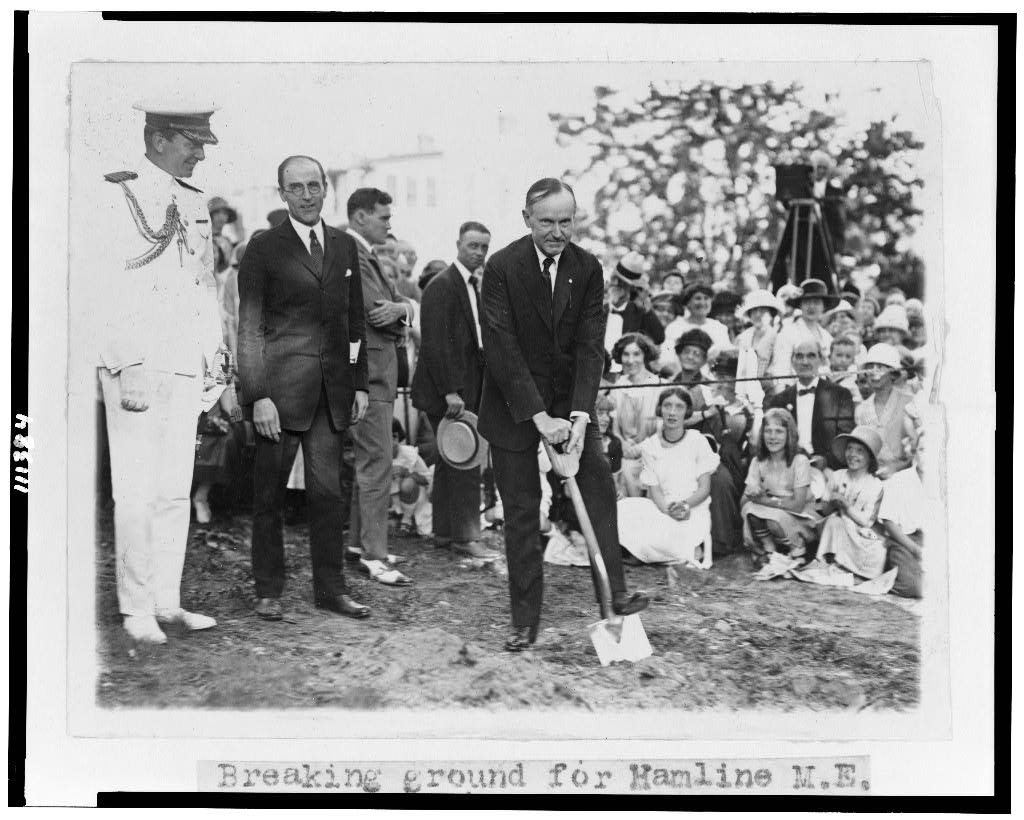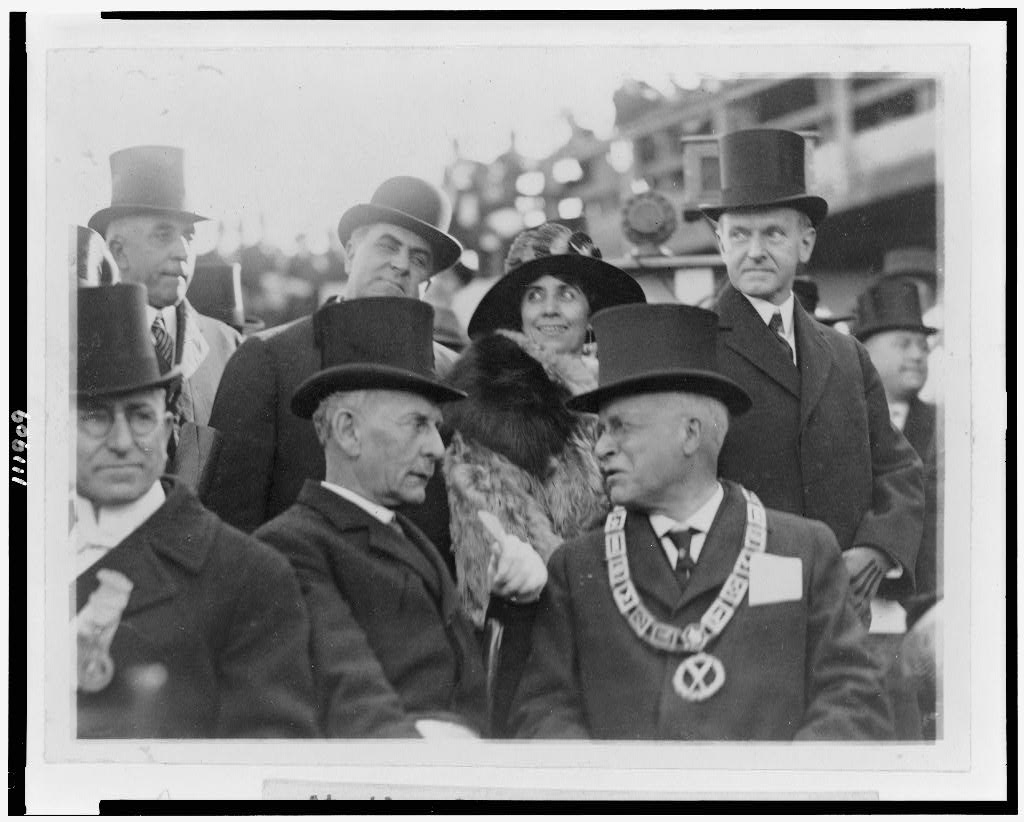On one particular occasion, Calvin Coolidge was invited to dedicate the cornerstone of a local building. Presented with the ceremonial spade by the emcee, the President dutifully performed the honors and prepared to leave. Gently reminded that it was customary to say a few words, he paused to look at the clod of dirt he had just overturned as if something very profound was on his mind for this occasion. Gazing intently at the ground for a moment, he noticed a plump nightcrawler emerging from the freshly disturbed earth. Without a hint of a smile, he uttered the droll phrase above and went on his way. If there was any laughter by those who got the joke, he never waited to be appreciated for the punchline. Cal was already on to the next task. Such was the dry and homespun humor of our thirtieth president.
human nature
On Dedicating National Treasures
While we could venture to decipher the degrees of separation between Calvin Coolidge and Nicholas Cage, who, it is rumored, will reprise his role as Ben Gates next year in the third National Treasure film, we find that reality is both more interesting and more instructive. The original manuscripts of the Constitution and Declaration of Independence spent much of our nation’s history en route to somewhere more permanent and protected. The Declaration, being of course the older of the two, followed Congress through Pennsylvania, Maryland, New Jersey, New York and back again before coming to Washington in 1800 at the direction of President Adams. These two National treasures would move again when the British threatened the Capital and once more when the Japanese attacked Pearl Harbor but 1921 found them in the papers of the State Department, under the responsibility of the new Secretary of State, Charles Evans Hughes. It was Hughes who quickly recognized the urgent need of securing those invaluable documents in a place befitting their importance. After many years of travel and duplication, especially after the “wet transfer” method inflicted on the Declaration by William J. Stone (authorized by then Secretary of State, John Quincy Adams) in 1820, the documents needed protection from light, moisture and fire. Keeping them in facilities that were anything but fireproof was unthinkable to Hughes or his chief, President Harding.
The Secretary went to Harding with an executive order approving transfer of these historic charters to the custody and care of competent archivists at the Library of Congress, where they could be displayed inside specially-designed frames in a secure yet dignified setting. The Librarian of Congress, Herbert Putnam, eagerly prepared to receive and display both manuscripts. To sell the Budget Bureau on the idea, Librarian Putnam explained how he envisioned the display would look, “There is a way…we could construct, say, on the second floor on the western side in that long open gallery a railed inclosure, material of bronze, where these documents, with one or two auxiliary documents leading up to them, could be placed, where they need not be touched by anybody but where a mere passer-by could see them, where they could be set in permanent bronze frames and where they could be protected from the natural light, lighted only by soft incandescent lamps. The result could be achieved and you would have something every visitor to Washington would wish to tell about when he returned…” A special mail truck delivered them and even before plans could be drawn up for their resting place, $12,000 in appropriations had been secured just before final estimates of the year were submitted by the Bureau in 1922.
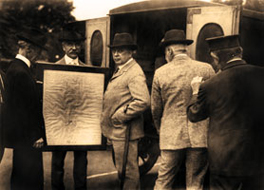
Transferring the Declaration from the offices of the State Department to the Library of Congress, September 30, 1921.

Mail truck is loaded with the Declaration and Constitution as Herbert Putnam, standing at center in the fedora, supervises this sensitive operation. Read more at http://www.archives.gov/exhibits.charters/declaration_history.html.
Francis H. Bacon began drawing a design for what journalists dubbed at the time, a “sort of shrine” to the great principles articulated in these two documents. It would be Bacon’s brother, Henry, who conceived the Lincoln Memorial which was dedicated in May that same year. It would not be until early 1924, however, before what was to be a suitable final resting place was ready for the Constitution and Declaration. Bronze frames with double-paned glass would house each manuscript. Between each pane of glass was placed a layer of gelatin film to block out any damage inflicted by light. Marble carefully selected from New York, Tennessee and, of course, Vermont, surrounded and supported the two bronze frames. Greek and Italian marble comprised the display’s flooring and ballustrade to match the materials in the rest of the Library. American materials only would have the closest contact with each document, however. A 24-hour guard would be placed to ensure the site remained protected. Gold-plated bronze doors would open to present the Declaration above the glass and marble case containing the Constitution. At last complete, the site would be dedicated by none other than President Calvin Coolidge, joined by Mrs. Coolidge, Secretary Hughes, Librarian of Congress Putnam, and numerous other dignitaries on February 28, 1924.
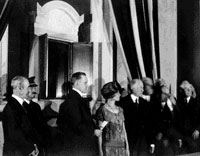
President and Mrs. Coolidge, with Mr. Putnam and others come together to ensure both documents are properly preserved for generations to come, February 28, 1924.
What struck everyone, and would distinguish that occasion from later dedication ceremonies, was its quiet simplicity. Unlike the 1952 move of that same historic pair of treasures to their current home at the National Archives, there were no elaborate ceremonies, no speeches, no troops, no Marine Corps Band. Those gathered witnessed a much humbler scene in the Great Hall of the Library of Congress on that February day in 1924. Two Library policemen held flags lowered in salute on either side of the display, raising them at the crucial moment to reveal the Declaration and Constitution viewable together at last. All remained silent as the Librarian of Congress, red-headed Herbert Putnam, stepped forward to place both documents into their respective bronze fittings. Finally a small choir of Library employees took up the familiar lines of Samuel Smith’s 1832 anthem, America. Attended by our red-headed President and Mrs. Coolidge, it was not long before many in the audience were singing along. No doubt Grace’s melodic voice stirred many present to join in that spontaneous expression of their love for America’s ideals. Together the crowd sang two stanzas and the ceremony was over. It was altogether a fitting tribute to the two greatest charters of liberty humanity has ever known.
My country, ’tis of Thee,
Sweet Land of Liberty
Of thee I sing;
Land where my fathers died,
Land of the pilgrims’ pride,
From every mountain side
Let Freedom ring.
…Our fathers’ God to Thee,
Author of Liberty,
To thee we sing,
Long may our land be bright
With Freedom’s holy light,
Protect us by thy might
Great God, our King.
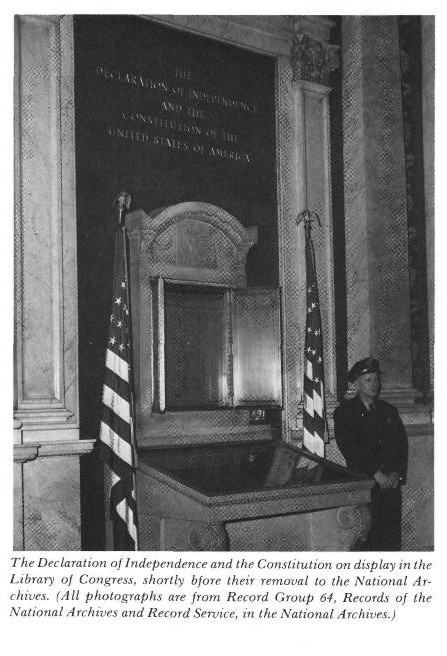
From “The Empty Shrine: The Transfer of the Declaration of Independence and the Constitution to the National Archives” by Milton O. Gustafson, published in American Archivist 39.3 (July 1976): 271-285. Digitized courtesy of the Society of American Archivists at http://archivists.metapress.com/content/n50n22w711j64203/fulltext.pdf. The materials comprising this display, emptied of the Declaration and Constitution, were finally placed into storage in the late 1990s.
For further reading see also:
John Y. Cole, “The Library and the Declaration: LC Has Long History with Founding Document,” The Library of Congress, http://www.loc.gov/loc/lcib/9708/declare.html (accessed June 4, 2014).
A comic strip narrating the 1924 dedication and subsequent history at the National Archives can be found in “Flashbacks” by Patrick M. Reynolds at http://www.redrosestudio.com/Natl%20Archives.html.
“James Madison vs. Barack Obama” by Burt Folsom
“James Madison vs. Barack Obama” by Burt Folsom
Taking a series of powerful reminders from the Progressive Era (1900-1920), Dr. Folsom reveals the inescapable flaws of trusting government bureaucracy with competence and responsibility for human life and the daily decisions we, as free individuals, are infinitely better equipped to make. It is the stark difference between the blind reliance on government “experts” and the wisdom of the Constitution in liberating people to choose for themselves rather than live at the behest of an unbounded bureaucracy. It is the naive notion of progressives then as now that tighter controls make happier people and better nations while constitutionalists, who understand what power does to human nature, embrace a limited government, where power is disbursed and held strictly accountable to the people. Constitutionalists grasp the inhumane character of bureaucracy because history has taught them political calculations take primacy over the liberty of people and an equal respect for the law. To constitutionalists, limiting what government can do, preserving equality under the law and retaining each person’s freedom to pursue happiness comprise the compassionate way. It is the recipe by which America has experienced so many blessings and so much success. Despite the best efforts of progressives, no bureaucratic system will ever come close to the tremendous success of constitutionalism, when it is practiced.
Our thirtieth president, living in the midst of the Progressive Era, understood this well. He would come down decisively on the side of rolling back the growth and expansion of government, looking to the ingenuity and ability of the people to govern themselves. His appraisal of real progress grounded in the sensible and prescient foundations of constitutionalism make Coolidge not only a rewarding subject to study but a necessary one today. No need to take my word for it, Coolidge encapsulates it best:
“When we contemplate the enormous power, autocratic and uncontrolled, which would have been created by joining the authority of government with the influence of business, we can better appreciate the wisdom of the fathers in their wise dispensation which made Washington the political center of the country and left New York to develop into its business center. They wrought mightily for freedom…When government comes unduly under the influence of business, the tendency is to develop an administration which closes the door of opportunity; becomes narrow and selfish in its outlook, and results in an oligarchy. When government enters the field of business with its great resources, it has a tendency to extravagance and inefficiency, but, having the power to crush all competitors, likewise closes the door of opportunity and results in monopoly” – November 19, 1925.
“No plan of centralization has ever been adopted which did not result in bureaucracy, tyranny, inflexibility, reaction, and decline. Of all forms of government, those administered by bureaus are about the least satisfactory to an enlightened and progressive people. Being irresponsible they become autocratic, and being autocratic they resist all development. Unless bureaucracy is constantly resisted it breaks down representative government and overwhelms democracy. It is the one element in our institutions that sets up the pretense of having authority over everybody and being responsible to nobody” – May 15, 1926.
“The government has never shown much aptitude for real business. The Congress will not permit it to be conducted by a competent executive, but constantly intervenes. The most free, progressive and satisfactory method ever devised for the equitable distribution of property is to permit the people to care for themselves by conducting their own business. They have more wisdom than any government” – January 5, 1931.
“Neither the state nor the Federal governments can supply the information and wisdom necessary to direct the business activity of the nation…The experience, skill and wisdom necessary to guide business cannot be elected or appointed. It has to grow up naturally from the people. The process is long and fraught with human sacrifice, but it is the only one that can work” – May 1, 1931.
In contrast to the destruction of society by bureaucracy, “There is another system with which every American should be familiar, a system of equality and of freedom, not without the claim of divine right but recognizing that such right reposes in the people; a system where the individual is clothed with inalienable rights, the people are supreme, the government is their agent. Under this conception there is real freedom, real independence, and grave personal responsibility. The rulers look to the people. Their authority is the public will, ascertained in accordance with law. There will be the least possible interference with private affairs. Realizing that it is the people who support the government and not the government which supports the people, there will be no resort to paternalism. Under such institutions there may be appear to be a lack of machine-like efficiency, but there will be no lack of character. Private initiative will be stimulated. Self-reliance and self-control will be increased. Society will remain a living organism sustaining hope and progress, content to extend its dominion not by conquest but by service. Such is the system of self-government, the orderly rule of the people, carrying within itself a remedy for its own disorders and the power of self-perpetuation. This is the ideal of America” – January 21, 1923.
Coolidge, one of our wisest constitutionalist Presidents, hits the mark, as usual, squarely and faithfully.
